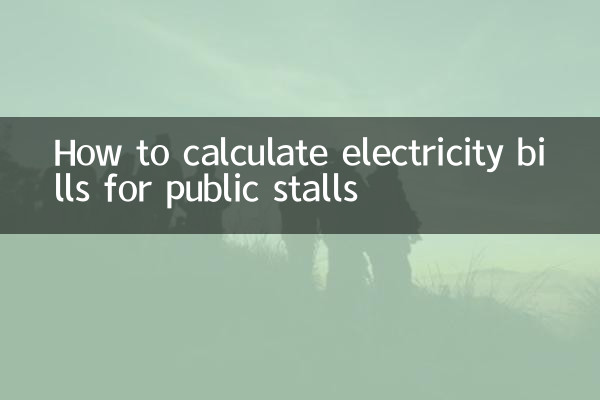How to calculate electricity bills for public stalls
In recent years, with the acceleration of urbanization, the problem of electricity consumption in public areas has gradually become the focus of residents' attention. The calculation method of public electricity bills is directly related to the financial burden of each household, so it is particularly important to understand its calculation method. This article will combine the hot topics and hot content on the Internet in the past 10 days to provide you with a detailed analysis of the calculation method of public electricity bills, and provide structured data for reference.
1. Definition of public electricity consumption

Public electricity consumption refers to the electricity consumption in public areas (such as elevators, corridor lighting, water pumps, fire-fighting facilities, etc.) in residential communities or commercial buildings. This part of the electricity bill is usually shared by all owners or tenants, and the specific sharing ratio and calculation method are determined by the property company or relevant management regulations.
2. Calculation method of electricity charges for public sharing
The calculation of public electricity bills is usually divided into the following methods:
| Calculation method | Specific instructions | Applicable scenarios |
|---|---|---|
| Evenly distributed per household | Evenly distribute the total cost of public electricity consumption to each household | Suitable for communities with similar residential areas |
| Apportioned by area | Allocate the cost according to the proportion of the floor area of the residents | Suitable for communities with large area differences |
| Apportioned according to frequency of use | Allocate costs based on frequency of use of public facilities | Suitable for commercial buildings or high-end residential buildings |
3. Specific calculation steps for electricity charges for public sharing
The following are the specific calculation steps for public electricity charges, taking apportionment by area as an example:
| steps | Operation | Example |
|---|---|---|
| 1. Statistics of the total electricity consumption of public stalls | Record total electricity usage in common areas (kWh) | 1000kWh |
| 2. Calculate the total electricity bill | Calculate total cost based on electricity price | 1000 kWh × 0.6 yuan/kWh = 600 yuan |
| 3. Determine the apportionment ratio | Apportioned according to the proportion of household area to total area | Household A has an area of 80㎡ and a total area of 800㎡, accounting for 10% |
| 4. Calculate the cost sharing for each household | Total cost × apportionment ratio | 600 yuan × 10% = 60 yuan |
4. Disputes and solutions over public electricity bills
In recent years, disputes over public electricity bills have occurred frequently, mainly focusing on the following aspects:
1.Fees are not transparent: Some property companies have not disclosed specific data on electricity consumption by public shares, causing residents to question the costs. Solution: Require properties to regularly publish electricity consumption data and cost details.
2.The allocation method is unreasonable: Some communities adopt the method of equal sharing per household, resulting in an overburden for residents with smaller areas. Solution: Push for apportionment by area or negotiate a more reasonable apportionment method.
3.Electricity bill is too high: The unit price of shared electricity charges charged by some property management companies is higher than the unit price of residential electricity. Solution: Verify the electricity price policy to ensure that charges comply with regulations.
5. How to reduce public electricity bills
1.Energy saving renovation: Replace lighting equipment in public areas with LED lights to reduce electricity consumption.
2.Intelligent management: Install smart meters to monitor public electricity consumption in real time to avoid waste.
3.Owner supervision: Establish an owners committee to supervise the property management company’s electricity management and charging behavior.
6. Summary
The calculation of shared electricity charges involves multiple factors, including total electricity consumption, allocation method and electricity price. Understanding these calculation methods can help residents protect their rights and avoid unnecessary financial burdens. At the same time, through energy-saving transformation and intelligent management, the cost of shared electricity consumption can be effectively reduced and the rational use of resources can be achieved.
I hope that the analysis in this article can help everyone better understand the calculation method of public electricity bills and make more informed decisions in real life.

check the details

check the details